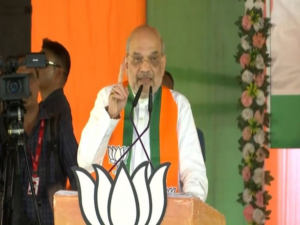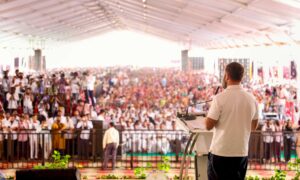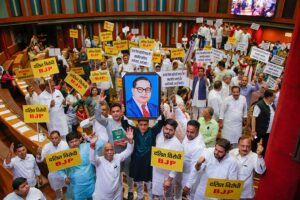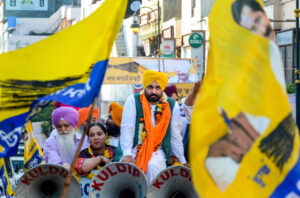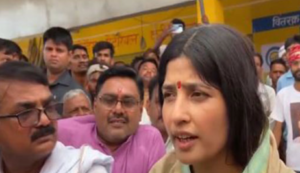New Parliament building highlights rich democratic traditions with modern touch
New Delhi, May 28 (PTI) Artworks on display in the new Parliament building, which was inaugurated by Prime Minister Narendra Modi on Sunday, narrate the stories of India’s democratic traditions from the Vedic period to the present day.
The growth of democracy in the country is depicted through a series of exhibits in the Constitution Hall on the new Parliament building, which itself is inspired by the Sri Yantra, used for worship in the Hindu traditions and considered a source of pure energy.
The Constitution Hall, which has a digitised copy of the Indian Constitution, has a touch of modernity as it also houses a Foucault’s Pendulum to demonstrate the rotation of the earth.
“Democracy is not just a system that is practiced in India but it is a culture, thought and tradition. Our vedas teach us about the democratic ideals of Sabha and Samiti. We find a description of the republic in Mahabharata,” Modi said.
The Foucault’s Pendulum hangs from a large skylight from the triangular roof of the Constitution Hall and signifies the idea of India with that of the universe.
The Lok Sabha and the Rajya Sabha chambers boast of a digitised voting system, well-engineered acoustics, and state-of-the-art audio-visual systems to ensure effective legislative proceedings.
The building has three ceremonial foyers where huge brass images of Mahatma Gandhi, Chanakya, Gargi, Sardar Vallabhbhai Patel, B R Ambedkar, and the Chariot Wheel from the Sun Temple at Konark are on display.
The public entrances lead to three galleries — the Sangeet Gallery which exhibits dance, song, and musical traditions of India; the Sthapthya Gallery depicts the architectural heritage of the country and the Shilp Gallery showcases distinct handicraft traditions of different states.
The new parliament building is home to nearly 5,000 artworks, including paintings, wall panels, stone sculptures and metal murals.
The interiors of the Lok Sabha chamber are based on the theme of the national bird peacock, while that of the Rajya Sabha depict national flower lotus.
According to officials, eminent musicians and their family members including Ustad Amjad Ali Khan, Pandit Hariprasad Chaurasia, Ustad Bismillah Khan, Pandit Ravi Shankar have donated their musical instruments for the Sangeet Gallery.
The four-storey Parliament House has a built up area of 64,500 sqm and has two chambers 888-seater Lok Sabha, which can accommodate 1,272 members for the joint sitting of both the Houses, and the 384-seater Rajya Sabha chamber.
The building opens into a central courtyard with a banyan tree. The new building also has six new committee rooms and 92 rooms for use as offices for the Council of Ministers.
The material used for the new building has been acquired from various parts of the country.
The teakwood used in the building was sourced from Nagpur in Maharashtra, while the red and white sandstone was procured from Sarmathura in Rajasthan. The sandstone for the Red Fort and Humayun’s Tomb in the national capital was also known to have been sourced from Sarmathura.
The Kesharia green stone has been procured from Udaipur, the red granite from Lakha near Ajmer and the white marble has been sourced from Ambaji in Rajasthan.
“In a way, the entire country came together to construct the temple of democracy, thus reflecting the true spirit of Ek Bharat Shreshtha Bharat,” an official said.
The steel structure for the false ceilings in the Lok Sabha and the Rajya Sabha chambers have been sourced from the union territory of Daman and Diu, while the furniture in the new building was crafted in Mumbai.
The stone ‘jaali’ (lattice) works dotting the building were sourced from Rajnagar in Rajasthan and Noida in Uttar Pradesh.
The materials for the Ashoka Emblem were sourced from Aurangabad in Maharashtra and Jaipur in Rajasthan, while the Ashok Chakra on the massive walls of the Lok Sabha and the Rajya Sabha chambers and the exteriors of the parliament building were procured from Indore in Madhya Pradesh.
The new Parliament building used manufactured sand or M-sand from Charkhi Dadri in Haryana for creating concrete mix for the construction activities.
M-Sand is considered environment friendly as it is manufactured by crushing large hard stones or granite and not by dredging of river beds.
The fly ash bricks used in the construction were sourced from Haryana and Uttar Pradesh, while brass works and pre-cast trenches were from Ahmedabad in Gujarat.



